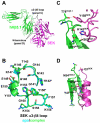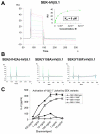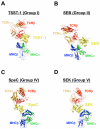A novel loop domain in superantigens extends their T cell receptor recognition site
- PMID: 17560605
- PMCID: PMC2949350
- DOI: 10.1016/j.jmb.2007.05.038
A novel loop domain in superantigens extends their T cell receptor recognition site
Abstract
Superantigens (SAGs) interact with host immune receptors to induce a massive release of inflammatory cytokines that can lead to toxic shock syndrome and death. Bacterial SAGs can be classified into five distinct evolutionary groups. Group V SAGs are characterized by the alpha3-beta8 loop, a unique approximately 15 amino acid residue extension that is required for optimal T cell activation. Here, we report the X-ray crystal structures of the group V SAG staphylococcal enterotoxin K (SEK) alone and in complex with the TCR hVbeta5.1 domain. SEK adopts a unique TCR binding orientation relative to other SAG-TCR complexes, which results in the alpha3-beta8 loop contacting the apical loop of framework region 4, thereby extending the known TCR recognition site of SAGs. These interactions are absolutely required for TCR binding and T cell activation by SEK, and dictate the TCR Vbeta domain specificity of SEK and other group V SAGs.
Figures





Similar articles
-
The T cell receptor beta-chain second complementarity determining region loop (CDR2beta governs T cell activation and Vbeta specificity by bacterial superantigens.J Biol Chem. 2011 Feb 11;286(6):4871-81. doi: 10.1074/jbc.M110.189068. Epub 2010 Dec 2. J Biol Chem. 2011. PMID: 21127057 Free PMC article.
-
Crystal structure of the streptococcal superantigen SpeI and functional role of a novel loop domain in T cell activation by group V superantigens.J Mol Biol. 2007 Apr 6;367(4):925-34. doi: 10.1016/j.jmb.2007.01.024. Epub 2007 Jan 12. J Mol Biol. 2007. PMID: 17303163
-
Three-dimensional structure of the complex between a T cell receptor beta chain and the superantigen staphylococcal enterotoxin B.Immunity. 1998 Dec;9(6):807-16. doi: 10.1016/s1074-7613(00)80646-9. Immunity. 1998. PMID: 9881971
-
Soluble T cell receptor Vβ domains engineered for high-affinity binding to staphylococcal or streptococcal superantigens.Toxins (Basel). 2014 Jan 28;6(2):556-74. doi: 10.3390/toxins6020556. Toxins (Basel). 2014. PMID: 24476714 Free PMC article. Review.
-
Structure-function studies of T-cell receptor-superantigen interactions.Immunol Rev. 1998 Jun;163:177-86. doi: 10.1111/j.1600-065x.1998.tb01196.x. Immunol Rev. 1998. PMID: 9700510 Review.
Cited by
-
Structure of Staphylococcal Enterotoxin E in Complex with TCR Defines the Role of TCR Loop Positioning in Superantigen Recognition.PLoS One. 2015 Jul 6;10(7):e0131988. doi: 10.1371/journal.pone.0131988. eCollection 2015. PLoS One. 2015. PMID: 26147596 Free PMC article.
-
Novel insights into the immune response to bacterial T cell superantigens.Nat Rev Immunol. 2024 Jun;24(6):417-434. doi: 10.1038/s41577-023-00979-2. Epub 2024 Jan 15. Nat Rev Immunol. 2024. PMID: 38225276 Review.
-
The structure of superantigen complexed with TCR and MHC reveals novel insights into superantigenic T cell activation.Nat Commun. 2010 Nov 16;1:119. doi: 10.1038/ncomms1117. Nat Commun. 2010. PMID: 21081917
-
Detection and measurement of staphylococcal enterotoxin-like K (SEl-K) secretion by Staphylococcus aureus clinical isolates.J Clin Microbiol. 2014 Jul;52(7):2536-43. doi: 10.1128/JCM.00387-14. Epub 2014 May 7. J Clin Microbiol. 2014. PMID: 24808237 Free PMC article.
-
Human scFvs That Counteract Bioactivities of Staphylococcus aureus TSST-1.Toxins (Basel). 2017 Feb 17;9(2):50. doi: 10.3390/toxins9020050. Toxins (Basel). 2017. PMID: 28218671 Free PMC article.
References
-
- McCormick JK, Yarwood JM, Schlievert PM. Toxic shock syndrome and bacterial superantigens: an update. Annu Rev Microbiol. 2001;55:77–104. - PubMed
-
- Sundberg EJ, Li Y, Mariuzza RA. So many ways of getting in the way: diversity in the molecular architecture of superantigen-dependent T-cell signaling complexes. Curr Opin Immunol. 2002;14:36–44. - PubMed
-
- Kaul R, McGeer A, Norrby-Teglund A, Kotb M, Schwartz B, O'Rourke K, Talbot J, Low DE. Intravenous immunoglobulin therapy for streptococcal toxic shock syndrome--a comparative observational study. The Canadian Streptococcal Study Group. Clin Infect Dis. 1999;28:800–7. - PubMed
-
- Li Y, Li H, Dimasi N, McCormick JK, Martin R, Schuck P, Schlievert PM, Mariuzza RA. Crystal structure of a superantigen bound to the high-affinity, zinc-dependent site on MHC class II. Immunity. 2001;14:93–104. - PubMed
Publication types
MeSH terms
Substances
Associated data
- Actions
Grants and funding
LinkOut - more resources
Full Text Sources
Miscellaneous

